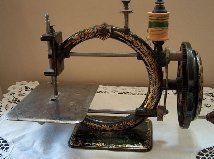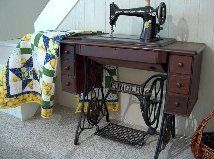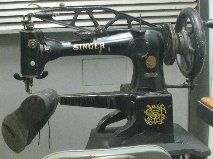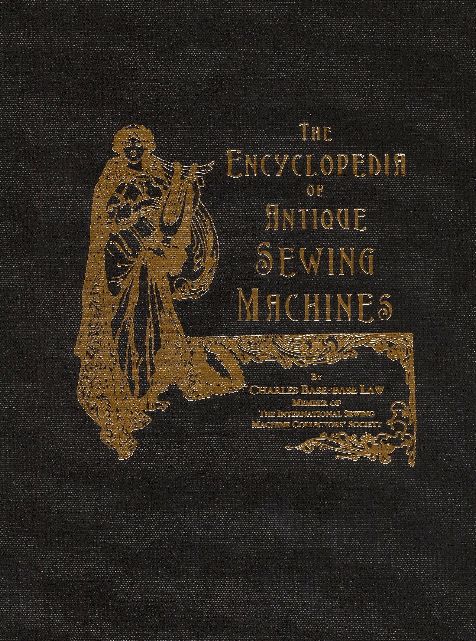By Carole (craftnut)

It’s national sewing machine day! Very little is known about the day to honor the sewing machine, but here is a bit of history about this wonderful invention. Many people believe that Singer invented the sewing machine, but he didn’t. The actual history is an amazing story of espionage and stolen ideas, worthy of a blockbuster film. In much the same way as our modern day Steve Jobs and Bill Gates had the war between Apple and Microsoft, in the 1800s there were Elias Howe and Isaac Singer.
The first documented sewing machine was made and patented in 1804 in France, but never made it off the ground. A German invention was patented in 1810, but didn’t function well and was abandoned. In 1830, a French tailor named Barthelemy Thimonnier patented a chain stitch machine using only one thread. His clothing factory was burned by rival tailors who feared the invention of the machine would put them out of work.
In 1834, Walter Hunt made the first sewing machine in America that actually worked well. He abandoned his invention because he believed it could cost jobs. He did not get a patent, which would prove to be a determining factor in a later patent fight.
The first American patent for a sewing machine was granted to Elias Howe in 1846. His design used a two-thread system. It used an oscillating shuttle to create the lockstitch. In the 1850s, Isaac Singer redesigned a Lerow and Blodgett machine and began production using the same lockstitch mechanism that Howe had patented but with a stationary head and straight needle. Thus began the patent wars, ending with a victory by Howe in 1854, in part due to Hunt not patenting his machine. Singer was forced to pay royalties to Howe, dramatically increasing Howe’s income to more than $200,000 a year, a real fortune in those days. Howe died in 1867, the same year his patent expired.
In 1850, inventor Allen Wilson invented the vibrating shuttle bobbin. He was immediately sued by the owners of another shuttle patent that had been granted in 1848. Rather than fight, Wilson agreed to sign over half interest in the shuttle. He then began work on a rotary hook design that endures to this day. The Wheeler and Wilson sewing machines were in peak production in the 1850s and 1860s. They were the leading producer of sewing machines at the time. Wilson was also the inventor of the feed dog mechanism and spring presser foot, both still in use today as well.
During the 1850s, so many sewing machine manufacturers were created that the owners of the patents were constantly suing other manufacturers to maintain their patents. This is known as the Sewing Machine Wars. In 1856, four manufacturers created The Sewing Machine Combination to pool their patents and force other manufacturers to obtain a license to manufacture sewing machines. These manufacturers were Wheeler & Wilson, Grover & Baker, Howe and Singer. They were not cooperative with each other, however, competing with each other to grant the licenses for their own designs. 
Goodspeed and Wyman was a sewing machine manufacturer in Massachusetts, which marketed single thread sewing machines under the name of Bartlett Sewing Machines. The faceplate is difficult to see, but has the name Goodspeed and Wyman, along with several patent dates ending in 1860, and the names Howe, Grover, Wilson and Singer Co visible. This would seem to indicate that the license fee was paid to the Combination. In 1866, a new patent was granted to Goodspeed and Wyman, but this patent number does not appear on this machine, indicating it was made prior to 1866.
In the 1870s when all the patents expired, The White Sewing Machine Company began to market its premier product, the Vibrating Shuttle Machine. After that model, the company began to produce a rotary hook model. At the same time, Singer began production of its vibrating shuttle models and became the leading manufacturer of sewing machines. Singer was the first to offer an installment payment plan, as machines were very expensive relative to the average salary of the day. 
This portable electrified vibrating shuttle machine was probably made around 1880, and is branded R. H. Macy & Co. Beginning in the 1800s, several manufacturers including White, Singer, Domestic and others manufactured machines for department stores with the store’s branding. Today, it is very difficult to determine a particular machine’s provenance if it is a store branded machine. Store branded machines made after World War II are mostly of Japanese manufacture.
Singer was not the hard working inventor that the company wants us to believe. Far from it, he was a shameless self-promoter, would-be actor and womanizer fathering 24 children with many different women. At his death, his multi-million dollar estate including a castle in England was divided between the 24 children and three of their mothers. Singer dominated the global sewing machine market until the 1960s. Severe competition over the next three decades forced the Singer Company into bankruptcy in 1999.
 The Singer machine pictured on the left was originally a treadle machine and was converted to electric later by the addition of a power supply. It is a rotary hook machine. The serial number dates it to 1924. Of the domestic makers, only Singer kept meticulous records of its own machines. No matter how old your Singer is, anyone can discover the date his or her Singer machine was made and where it was made by the serial number.
The Singer machine pictured on the left was originally a treadle machine and was converted to electric later by the addition of a power supply. It is a rotary hook machine. The serial number dates it to 1924. Of the domestic makers, only Singer kept meticulous records of its own machines. No matter how old your Singer is, anyone can discover the date his or her Singer machine was made and where it was made by the serial number.
Singer was a supplier of machines to the military as well. The machine on the right, which was primarily used to repair shoes, is on the aircraft  carrier USS Yorktown located in Charleston, SC. Since the Yorktown was commissioned in 1943, it is reasonable to assume the machine was made that year.
carrier USS Yorktown located in Charleston, SC. Since the Yorktown was commissioned in 1943, it is reasonable to assume the machine was made that year.
In 1873, Helen Augusta Blanchard of Portland, Maine patented the first sewing machine to have a zigzag stitch. The zigzag machine was in use in Europe for years, but in America only the commercial machines had this feature. The innovation didn’t come into widespread manufacture for the home sewing market in the U.S. until the 1950s.
In 1893, Karl Friedrich Gegauf invented a hemstitch machine in Switzerland for the manufacturer Bernina. They entered the home sewing market in the 1920s, but didn’t become a major force in exporting to the United States until 1988. Bernina introduced the first portable zigzag sewing machine to the world in 1945. Bernina is also responsible for introducing the computerized machine in 1988. The company has been an innovative leader in sewing machine development.
 This Singer Featherweight was manufactured in Elizabeth, New Jersey in 1941. These machines are highly prized today because of their simple design, all metal parts, straight stitch and light weight. Modern quilters love them.
This Singer Featherweight was manufactured in Elizabeth, New Jersey in 1941. These machines are highly prized today because of their simple design, all metal parts, straight stitch and light weight. Modern quilters love them.
The Japanese entered the sewing machine manufacturing arena in 1908 with the Brother Sewing Machine Company, the first manufacturer to mass-produce sewing machines. In the 1920s, the Japanese company The Pine Sewing Machine Company was founded. The name was chosen to be palatable to the American market. The name was changed to Janome in 1954. Janome is a Japanese word meaning ‘eye of the snake’, so named because the round bobbin reminded the workers of a snake’s eye. In 1960, Janome purchased the New England based New Home sewing machine company, which had been in business for over 90 years. In 1990, Janome introduced the Memory Craft 8000 to the world market, which combined sewing and embroidery capabilities. Janome became a leading innovator in the modern computerized machines we use today.
Further reading on this interesting history can be found at these links –
http://www.moah.org/exhibits/virtual/sewing.html – Museum of American Heritage
http://oldsewingmachines.acandanex.co.uk/ – contains videos on how they work

There are a number of books on the history of sewing machines. I have the reference book The Encyclopedia of Antique Sewing Machines: A Reference Manual For The History, Identification, Maintenance, And Use Of Antique And Vintage Model Sewing Machines by Charles Basebase Law, but it is out of print. If you ever find a copy, buy it.

The First Conglomerate – 145 years of the Singer Company by Don Bissell

The Encyclopedia of Early American Sewing Machines, Identification & Values by Carter Bays

Singer and the Sewing Machine: A Capitalist Romance by Ruth Brandon

The History of the Sewing Machine by James Parton

Old Sewing Machines by Carol Head


Very interesting – thanks for the thorough article.
Something I wouldn’t normally look into researching, but was interested to read about.
🙂
I never knew all this about sewing machines! (My mom was a seamstress, so the details on this subject are especially fascinating to hear!)
Very cool! My gramma actually had the tredle model. I remember from when I was little.